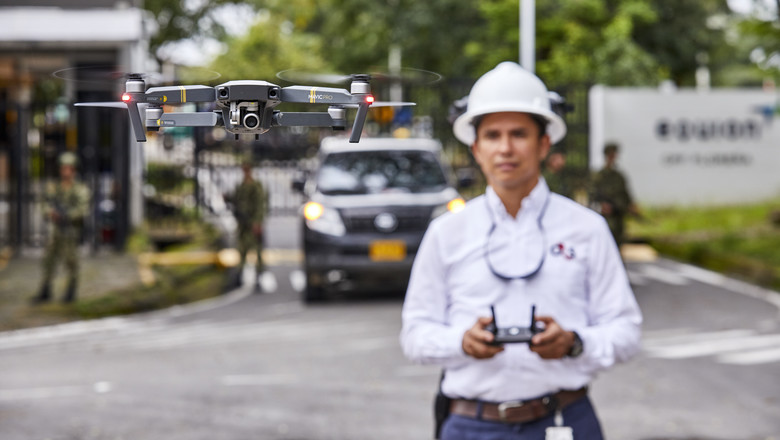
Security and drones:
A force for good

When people think about drones, it’s generally not in a positive light. But the technology that has long been viewed as a means to invade privacy, or threaten businesses, governments and industrial operations, actually has the potential to play a significant role in integrated security programmes.
And with so many models available today, and more being developed – from consumer products that can be bought freely at electronics stores to commercial-grade piloted and autonomous drones – this trend is only set to increase.
Until recently, the relationship between drones and security has been broadly negative, with companies turning to G4S for help in understanding the risk – whether it be the energy sector looking to protect critical infrastructure, businesses trying to keep new premises and products under wraps, or the entertainment industry wanting to keep prying eyes away from film sets.

A force for good
But, despite the risk they pose, drone technology offers real possibilities to the security industry. Our customers – particularly in the mining and oil and gas industries have already expressed an interest in drone-assisted security programmes.
One of the most common uses for drones at the moment is in perimeter security. It’s significantly more cost effective – and safer for personnel – for an always-on-duty drone to patrol along the outskirts of a property, rather than having a security officer patrol the entire area, or outfitting a large perimeter with a complex deployment of cameras and sensors.
Plus there’s the bonus of using that flight for inspection purposes. Based on the technology, optics or sensors fitted on the drone, you could be collecting a host of valuable information, all at incredible 4K resolution. If there does happen to be a security breach, a drone can usually navigate to a location significantly faster than a person could to assess the risk level – and it can also act as a visible deterrent to intruders once it arrives at the scene.
The protection of remote assets, be it pipelines, wind farms or mines, is another area where drones can prove extremely useful. In remote areas where infrastructure is minimal, it’s challenging and cost-prohibitive to deploy cameras and post security officers on site 24/7. Drones are able to cover linear distances of four to five miles per mission over different terrains, reaching speeds of up to 60mph in just over four seconds – all while sending live video and data back to a security operations centre.
The technology can also be used to provide crucial information to first responders and search and rescue teams, or monitor a host of different scenarios: natural disasters such as wild fires or floods, providing information on which direction the crisis is heading; motor vehicle incidents, assessing whether there is any further risk, or if any flammable products have been spilled; traffic flows and road congestion; and demonstration or protesting activities. Drones can even act as a public announcement system – the list goes on.
Tethered drones, too, are inherently useful from a security standpoint. These drones can remain secured to a power source for as long as is required, staying airborne for days rather than the typical 30–40 minute flight time.
But what is really interesting is the payloads that can be attached to the drones. A small cell source could provide a temporary signal for mobile phones when the network capacity within an area is overloaded – at a festival, for example.
Or a radio tower could allow security and safety services, police or first responders to communicate during a natural disaster, when the mobile phone networks are down. Whatever the need, a network can be rapidly deployed.
The future is autonomous
In North America, G4S is working with organisations across the globe, and strategically selecting manufacturing partners, to integrate the best drone solutions possible. It may look like we’re taking our time with this technology, but it’s important to be diligent and smart when it comes to choosing a strategic partner – we don’t want to put anything out there that doesn’t completely integrate into our existing and future security ecosystem.
What we’re really focusing in on at the moment is autonomous technology. More and more drone systems are being used autonomously with various sensors to carry out certain actions upon the detection of a potential security breach. For example, a drone can be activated if a sensor is tripped on a secured fence. The drone can sweep the area with a thermal scanning device, search for intruders and automatically alert local law enforcement services and any other concerned parties. If an intruder is detected, the drone can follow his or her path and capture all the footage for further investigation.
From an automation and efficiency standpoint, autonomous drones face many obstacles in the form of certain licenses, and rules and regulations from the Federal Aviation Administration. So the platform we’re choosing will be able to be controlled by an operator via a laptop, a tablet or a mobile device – autonomous but with a manual override. We’re currently in the process of rolling out pilot projects with a few select customers.
And we have so many other reasons to be excited for the future. There will be advances in battery technology, resulting in longer flight times; stronger parts, making it easier to fly at greater speeds and in harsher conditions; different payloads to be incorporated; and more advanced IoT (Internet of Things) sensors, computer vision and robotics – which could allow the drone to communicate with different sensors across a network automatically.
Ultimately, a drone should be nothing more than another advanced sensor that seamlessly integrates into your security portfolio. That’s the future.
About Joe
Joe Young is the Sr. Director of Cloud & Enterprise Solutions for G4S, overseeing technology, strategy and innovation for the G4S Secure Integration managed services division.
Additional Drone Expertise from G4S Corporate Risk Services
G4S Corporate Risk Services delivers specialised solutions that mitigate enterprise security threats. Our Risk Consulting team specialises in optimising business continuity strategies and programmes, including security audits and supply chain security. Our Intelligence Program team identifies, analyses and reports organisational threats and provides situational awareness services from our Global Risk Intelligence Center (GRIC).
Earlier this year, analysts from G4S Corporate Risk Services published Drones: Threat from Above, an intelligence bulletin consisting of a threat overview, a drone-use timeline, weaponisation tactics & techniques and scenarios used by terrorists and other criminal elements. The report also contains common security measures and threat mitigation recommendations.
